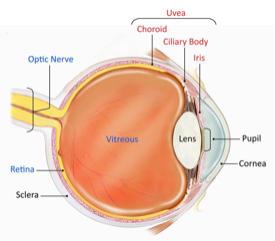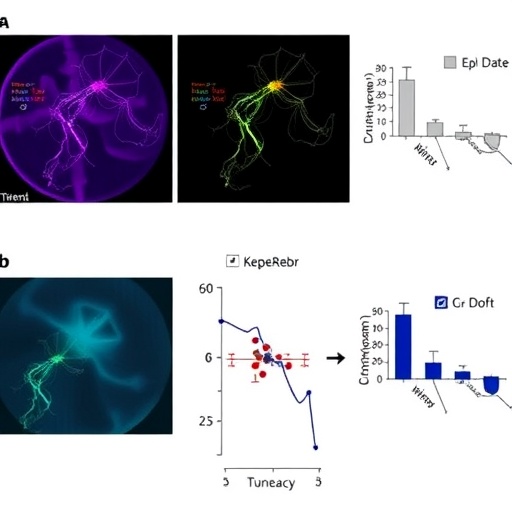NIH-funded classification criteria will facilitate clinical research for new therapies
An international coalition of eye researchers used machine learning to develop classification criteria for 25 of the most common types of uveitis, a collection of over 30 diseases characterized by inflammation inside the eye. Together, these diseases are the fifth leading cause of blindness in the United States. The Standardization of Uveitis Nomenclature (SUN) Working Group, funded by the National Eye Institute (NEI), published its classification criteria in the American Journal of Ophthalmology. NEI is part of the National Institutes of Health.
“In the past, clinical research in the field of uveitis has been hampered by the lack of widely-accepted and validated diagnostic criteria,” said Douglas A. Jabs, M.D., M.B.A., the SUN project leader and professor of epidemiology and ophthalmology, Johns Hopkins Bloomberg School of Public Health, Baltimore. “These classification criteria are a major step forward for epidemiological studies, translational studies, pathogenesis research, outcomes research, and clinical trials. They hopefully will yield better disease-specific approaches to diagnosis and treatment.”
In uveitis, inflammation can be seen in the anterior chamber (anterior uveitis), vitreous (intermediate uveitis), choroid, or retina (posterior uveitis), or all of these (panuveitis). Disease course, complications of uveitis, and the effect on vision vary dependent on the specific disease. Some uveitis appears abruptly and resolves. But many cases are recurrent or chronic, requiring long-term therapy. Symptoms may include floaters, vision loss, pain, and light sensitivity. Uveitis can strike at any age and can have a major impact on quality of life.
Until recently, classification of uveitis was based on the primary location of inflammation. However, types of uveitis affecting the same anatomic location can have different causes, courses, prognoses, and treatment needs. Previous work by the SUN Working Group demonstrated that even uveitis experts can disagree on diagnosis, making apples-to-apples comparisons difficult when conducting clinical research.
“The agreement among uveitis experts on the diagnosis of individual diseases was modest at best. So, we set off to try to provide clarity, using informatics, formal consensus techniques, and technology to assist in classifying each uveitic disease,” said Jabs.
The SUN Working Group, a team of nearly 100 international uveitis experts from more than 20 countries and 60 clinical centers, worked together throughout the project, which was conducted in four phases: informatics, case collection, case selection, and machine learning. The researchers used machine learning, a type of artificial intelligence, to help them identify the important characteristics that distinguished each disease.
The informatics phase involved standardizing language to describe each type of uveitis and the mapping of terms to individual diseases. In the case collection phase, the team entered 5,766 cases into a database, averaging 100-250 of each uveitis type. During the case selection phase, committees of nine uveitis experts reviewed the cases and used formal consensus techniques to determine whether they were a specific identifiable disease. Only cases with a more than 75% agreement among experts were included in the final database. The resulting cases (4,046) were put through machine learning using multiple approaches on a subset of the cases (“training set”) and the performance of the criteria determined on a second subset of the cases (the “validation set”).
The overall performance of the criteria was over 90% within uveitic class, suggesting that the criteria can be used in clinical and translational research. The final step was approval of the proposed criteria by the SUN Working Group.
“The SUN Working Group is excited about this unprecedented effort coming to fruition and the publication of this work, as it should provide the basis for future clinical research in the field of uveitis.” concluded Dr. Jabs.
###
The work was supported by grant R01 EY026593-05.
Visit the NEI’s online information about uveitis.
References:
1. Trusko B, Thorne J, Jabs DA, Belfort R, Dick A, Gangaputra S, Nussenblatt R, Okada A, Rosenbaum J. The Standardization of Uveitis Nomenclature (SUN) Project. Development of a clinical evidence base utilizing informatics tools and techniques. Methods Inf Med 2013;52:259-65.
2. Jabs DA, Dick A, Doucette JT, Gupta A, Lightman S, McCluskey P, Okada AA, Palestine AG, Rosenbaum JT, Saleem SM, Thorne JE, Trusko B, for the Standardization of Uveitis Nomenclature Working Group. Interobserver agreement among uveitis experts on uveitic diagnoses: The Standardization of Uveitis Nomenclature experience. Am J Ophthalmol 2018;186:19-24.
3. The Standardization of Uveitis Nomenclature Working Group. Development of classification criteria for the uveitides. Am J Ophthalmol 2021; in press. Journal Pre-Proof Published online: April 9, 2021
4. The Standardization of Uveitis Nomenclature Working Group. Classification criteria for cytomegalovirus anterior uveitis. Am J Ophthalmol 2021; in press. Journal Pre-Proof Published online: April 9, 2021
5. The Standardization of Uveitis Nomenclature Working Group. Classification criteria for herpes simplex virus anterior uveitis. Am J Ophthalmol 2021; in press. Journal Pre-Proof Published online: April 8, 2021
6. The Standardization of Uveitis Nomenclature Working Group. Classification criteria for varicella zoster virus anterior uveitis. Am J Ophthalmol 2021; in press. Journal Pre-Proof Published online: April 9, 2021
7. The Standardization of Uveitis Nomenclature Working Group. Classification criteria for Fuchs uveitis syndrome. Am J Ophthalmol 2021; in press. Journal Pre-Proof Published online: April 9, 2021
8. The Standardization of Uveitis Nomenclature Working Group. Classification criteria for juvenile idiopathic arthritis-associated chronic anterior uveitis. Am J Ophthalmol 2021; in press. Journal Pre-Proof Published online: April 9, 2021
9. The Standardization of Uveitis Nomenclature Working Group. Classification criteria for spondyloarthritis/HLA-B27-associated anterior uveitis. Am J Ophthalmol 2021; in press. Journal Pre-Proof Published online: April 9, 2021
10. The Standardization of Uveitis Nomenclature Working Group. Classification criteria for tubulointerstitial nephritis with uveitis syndrome. Am J Ophthalmol 2021; in press. Journal Pre-Proof Published online: April 9, 2021
11. The Standardization of Uveitis Nomenclature Working Group. Classification criteria for multiple sclerosis-associated intermediate uveitis. Am J Ophthalmol 2021; in press. Journal Pre-Proof Published online: April 9, 2021
12. The Standardization of Uveitis Nomenclature Working Group. Classification criteria for pars planitis. Am J Ophthalmol 2021; in press. Journal Pre-Proof Published online: April 8, 2021
13. The Standardization of Uveitis Nomenclature Working Group. Classification criteria for intermediate uveitis, non-pars planitis type. Am J Ophthalmol 2021; in press. Journal Pre-Proof Published online: April 8, 2021
14. The Standardization of Uveitis Nomenclature Working Group. Classification criteria for acute retinal necrosis syndrome. Am J Ophthalmol 2021; in press. Journal Pre-Proof Published online: April 9, 2021
15. The Standardization of Uveitis Nomenclature Working Group. Classification criteria for cytomegalovirus retinitis. Am J Ophthalmol 2021; in press. Journal Pre-Proof Published online: April 9, 2021
16. The Standardization of Uveitis Nomenclature Working Group. Classification criteria for syphilitic uveitis. Am J Ophthalmol 2021; in press. Journal Pre-Proof Published online: April 8, 2021
17. The Standardization of Uveitis Nomenclature Working Group. Classification criteria for toxoplasmic retinitis. Am J Ophthalmol 2021; in press. Journal Pre-Proof Published online: April 9, 2021
18. The Standardization of Uveitis Nomenclature Working Group. Classification criteria for tubercular uveitis. Am J Ophthalmol 2021; in press. Journal Pre-Proof Published online: April 9, 2021
19. The Standardization of Uveitis Nomenclature Working Group. Classification criteria for acute posterior multifocal placoid pigment epitheliopathy. Am J Ophthalmol 2021; in press. Journal Pre-Proof Published online: April 8, 2021
20. The Standardization of Uveitis Nomenclature Working Group. Classification criteria for birdshot chorioretinitis. Am J Ophthalmol 2021; in press. Journal Pre-Proof Published online: April 9, 2021
21. The Standardization of Uveitis Nomenclature Working Group. Classification criteria for multiple evanescent white dot syndrome. Am J Ophthalmol 2021; in press. Journal Pre-Proof Published online: April 9, 2021
22. The Standardization of Uveitis Nomenclature Working Group. Classification criteria for multifocal choroiditis with panuveitis. Am J Ophthalmol 2021; in press. Journal Pre-Proof Published online: April 9, 2021
23. The Standardization of Uveitis Nomenclature Working Group. Classification criteria for punctate inner choroiditis. Am J Ophthalmol 2021; in press. Journal Pre-Proof Published online: April 9, 2021
24. The Standardization of Uveitis Nomenclature Working Group. Classification criteria for serpiginous choroiditis. Am J Ophthalmol 2021; in press. Journal Pre-Proof Published online: April 9, 2021
25. The Standardization of Uveitis Nomenclature Working Group. Classification criteria for Behçet disease uveitis. Am J Ophthalmol 2021; in press. Journal Pre-Proof Published online: April 9, 2021
26. The Standardization of Uveitis Nomenclature Working Group. Classification criteria for sarcoidosis-associated uveitis. Am J Ophthalmol 2021; in press. Journal Pre-Proof Published online: April 9, 2021
27. The Standardization of Uveitis Nomenclature Working Group. Classification criteria for sympathetic ophthalmia. Am J Ophthalmol 2021; in press. Journal Pre-Proof Published online: April 9, 2021
28. The Standardization of Uveitis Nomenclature Working Group. Classification criteria for Vogt-Koyanagi-Harada disease. Am J Ophthalmol 2021; in press. Journal Pre-Proof Published online: April 9, 2021
NEI leads the federal government’s research on the visual system and eye diseases. NEI supports basic and clinical science programs to develop sight-saving treatments and address special needs of people with vision loss. For more information, visit https:/
About the National Institutes of Health (NIH): NIH, the nation’s medical research agency, includes 27 Institutes and Centers and is a component of the U.S. Department of Health and Human Services. NIH is the primary federal agency conducting and supporting basic, clinical, and translational medical research, and is investigating the causes, treatments, and cures for both common and rare diseases. For more information about NIH and its programs, visit https:/
NIH…Turning Discovery Into Health®
Media Contact
Claudia Costabile
[email protected]
Original Source
https:/
Related Journal Article
http://dx.





